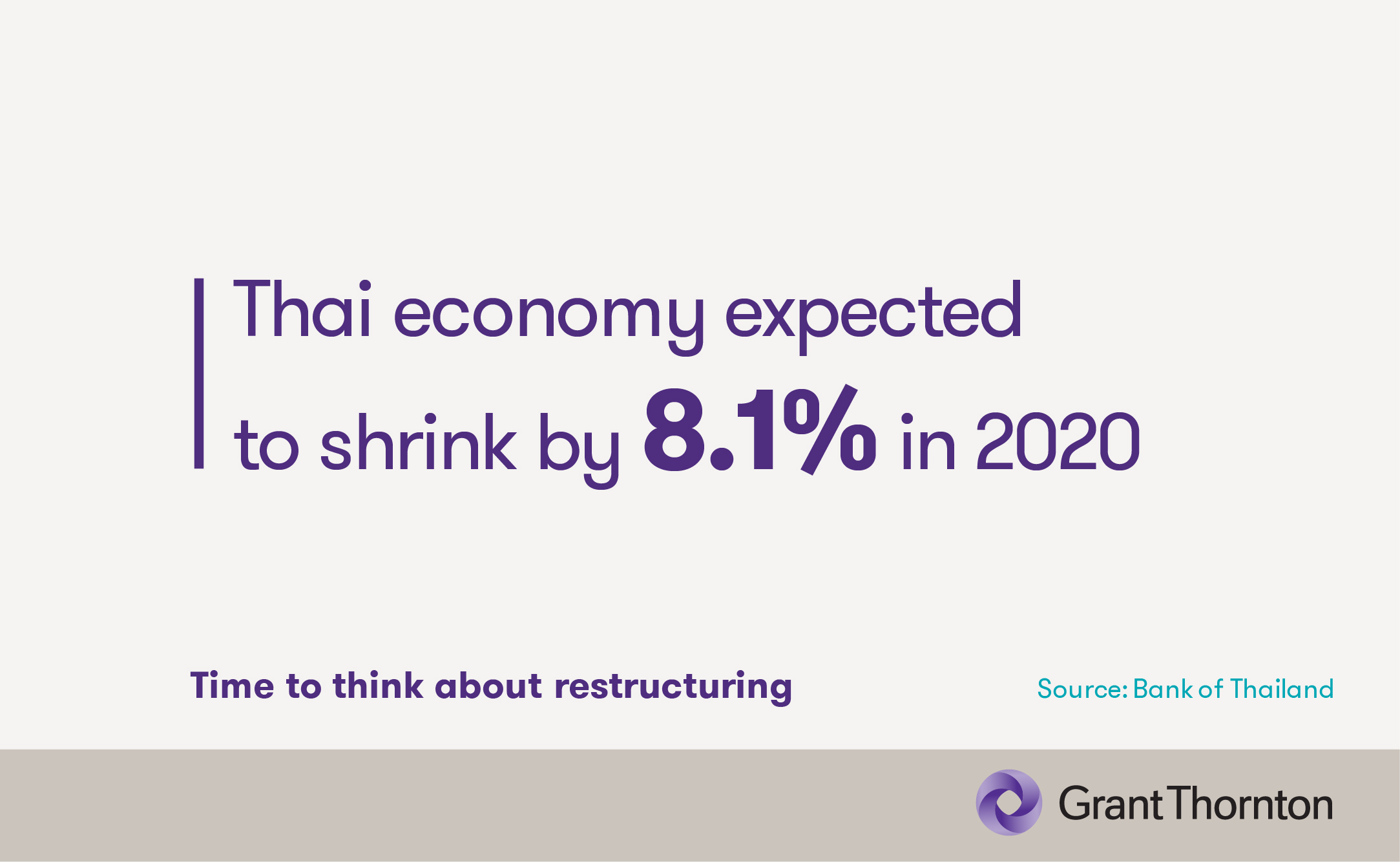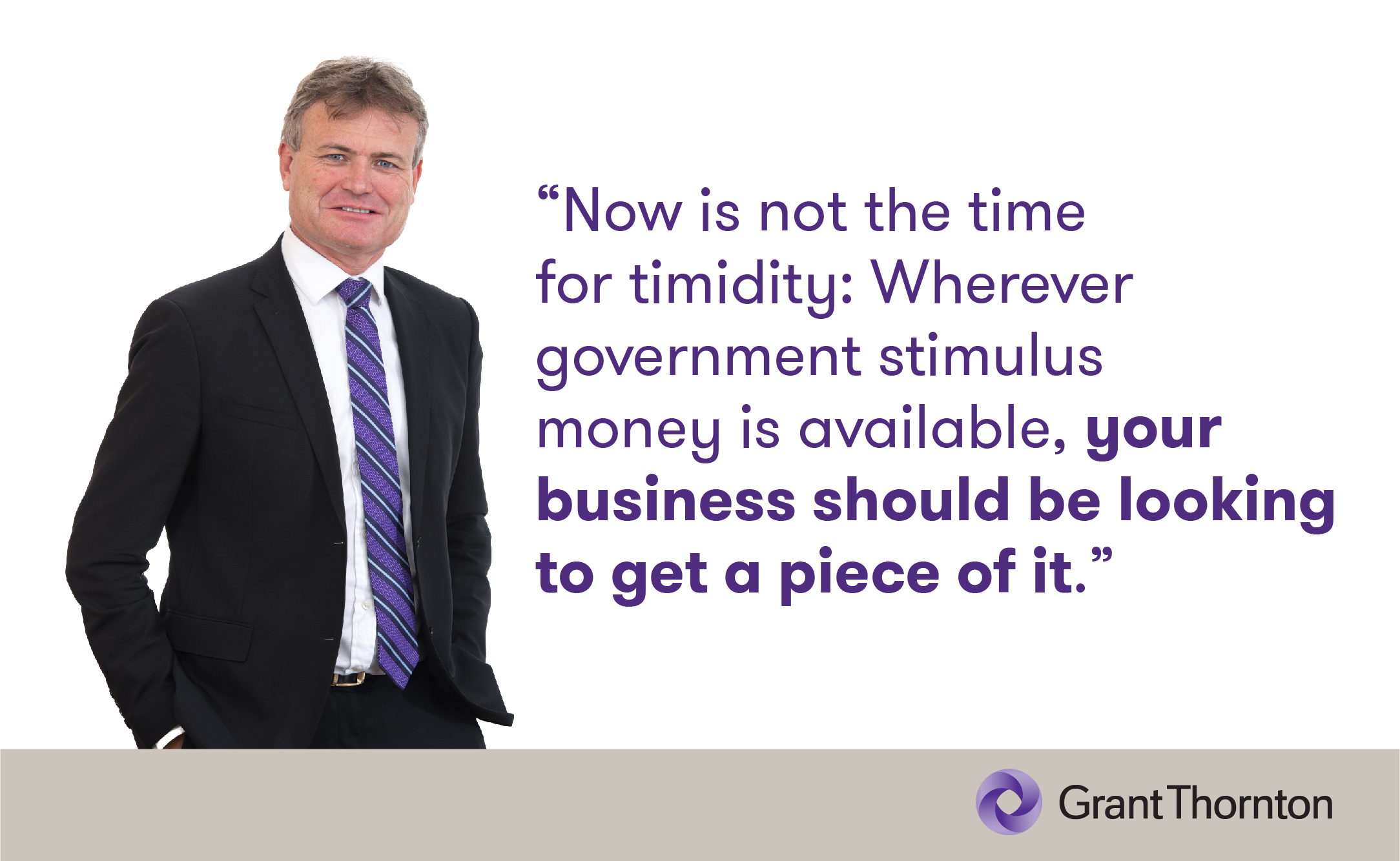-
Internal audit
In today's increasingly competitive and regulated market place, organisations - both public and private - must demonstrate that they have adequate controls and safeguards in place. The availability of qualified internal audit resources is a common challenge for many organisations.
-
IFRS
At Grant Thornton, our International Financial Reporting Standards (IFRS) advisers can help you navigate the complexity of financial reporting so you can focus your time and effort on running your business.
-
Audit quality monitoring
Having a robust process of quality control is one of the most effective ways to guarantee we deliver high-quality services to our clients.
-
Global audit technology
We apply our global audit methodology through an integrated set of software tools known as the Voyager suite.
-
Looking for permanent staff
Grant Thornton's executive recruitment is the real executive search and headhunting firms in Thailand.
-
Looking for interim executives
Interim executives are fixed-term-contract employees. Grant Thornton's specialist Executive Recruitment team can help you meet your interim executive needs
-
Looking for permanent or interim job
You may be in another job already but are willing to consider a career move should the right position at the right company become available. Or you may not be working at the moment and would like to hear from us when a relevant job comes up.
-
Practice areas
We provide retained recruitment services to multinational, Thai and Japanese organisations that are looking to fill management positions and senior level roles in Thailand.
-
Submit your resume
Executive recruitment portal
-
Update your resume
Executive recruitment portal
-
Available positions
Available positions for executive recruitment portal
-
General intelligence assessments
The Applied Reasoning Test (ART) is a general intelligence assessment that enables you to assess the level of verbal, numerical reasoning and problem solving capabilities of job candidates in a reliable and job-related manner.
-
Candidate background checks
We provide background checks and employee screening services to help our clients keep their organisation safe and profitable by protecting against the numerous pitfalls caused by unqualified, unethical, dangerous or criminal employees.

-
Capital markets
If you’re buying or selling financial securities, you want corporate finance specialists experienced in international capital markets on your side.
-
Corporate simplification
Corporate simplification
-
Expert witness
Expert witness
-
Family office services
Family office services
-
Financial models
Financial models
-
Forensic Advisory
Investigations
-
Independent business review
Does your company need a health check? Grant Thornton’s expert team can help you get to the heart of your issues to drive sustainable growth.
-
Mergers & acquisitions
Mergers & acquisitions
-
Operational advisory
Grant Thornton’s operational advisory specialists can help you realise your full potential for growth.
-
Raising finance
Raising finance
-
Restructuring & Reorganisation
Grant Thornton can help with financial restructuring and turnaround projects, including managing stakeholders and developing platforms for growth.
-
Risk management
Risk management
-
Technology & Digital Services
Technology Services
-
Transaction advisory
Transaction advisory
-
Valuations
Valuations
-
Human Capital Consulting
From time to time, companies find themselves looking for temporary accounting resources. Often this is because of staff leaving, pressures at month-end and quarter-end, or specific short-term projects the company is undertaking.
-
Strategy & Business Model
Strategy & Business Model
-
Process Optimisation & Finance Transformation
Process Optimisation & Finance Transformation
-
System & Technology
System & Technology
-
Digital Transformation
Digital Transformation
-
International tax
With experts working in more than 130 countries, Grant Thornton can help you navigate complex tax laws across multiple jurisdictions.
-
Licensing and incentives application services
Licensing and incentives application services
-
Transfer pricing
If your company operates in more than one country, transfer pricing affects you. Grant Thornton’s experts can help you manage this complex and critical area.
-
Global mobility services
Employing foreign people in Australia, or sending Australian people offshore, both add complexity to your tax obligations and benefits – and we can guide you through them.
-
Tax compliance and tax due diligence review services
Tax compliance
-
Value-Added Tax
Value-Added Tax
-
Customs and Trade
Customs and Trade
-
Service Line
グラントソントン・タイランド サービスライン
-
Business Process Outsourcing
Companies, large and small, need to focus on core activities. Still, non-core activities are important, and they need to be leaner and more efficient than most companies can make them sustainably. For Grant Thornton, your non-core activities are our core business. Grant Thornton’s experienced outsourcing team helps companies ensure resilience, improve performance, manage costs, and enhance agility in resourcing and skills. Who better to do this than an organisation with 73,000 accountants? At Grant Thornton we recognise that that outsourcing your F&A functions is a strategic decision and an extension of your brand. This means we take your business as seriously as we take our own.
-
Technology and Robotics
We provide practical digital transformation solutions anchored in business issues and opportunities. Our approach is not from technology but from business. We are particularly adept at assessing and implementing fast and iterative digital interventions which can drive high value in low complex environments. Using digital solutions, we help clients create new business value, drive efficiencies in existing processes and prepare for strategic events like mergers. We implement solutions to refresh value and create sustainable change. Our solutions help clients drive better and more insightful decisions through analytics, automate processes and make the most of artificial intelligence and machine learning. Wherever possible we will leverage your existing technologies as our interest is in solving your business problems – not in selling you more software and hardware.
-
Technical Accounting Solutions
The finance function is an essential part of the organisation and chief financial officer (CFO) being the leader has the responsibility to ensure financial discipline, compliance, and internal controls. As the finance function is critical in every phase of a company’s growth, the CFO role also demands attention in defining business strategy, mitigating risks, and mentoring the leadership. We offer technical accounting services to finance leaders to help them navigate complex financial and regulatory environments, such as financial reporting and accounting standards, managing compliance requirements, and event-based accounting such as dissolutions, mergers and acquisitions.
-
Accounting Services
Whether you are a local Thai company or a multinational company with a branch or head office in Thailand you are obliged to keep accounts and arrange for a qualified bookkeeper to keep and prepare accounts in accordance with accounting standards. This can be time consuming and even a little dauting making sure you conform with all the regulatory requirements in Thailand and using Thai language. We offer you complete peace of mind by looking after all your statutory accounting requirements. You will have a single point of contact to work with in our team who will be responsible for your accounts – no matter small or large. We also have one of the largest teams of Xero Certified Advisors in Thailand ensuring your accounts are maintained in a cloud-based system that you have access to too.
-
Staff Augmentation
We offer Staff Augmentation services where our staff, under the direction and supervision of the company’s officers, perform accounting and accounting-related work.
-
Payroll Services
More and more companies are beginning to realize the benefits of outsourcing their noncore activities, and the first to be outsourced is usually the payroll function. Payroll is easy to carve out from the rest of the business since it is usually independent of the other activities or functions within the Accounting Department. At Grant Thornton employees can gain access to their salary information and statutory filings through a specialised App on their phone. This cuts down dramatically on requests to HR for information by the employees and increases employee satisfaction. We also have an optional leave approval app too if required.
-
 IBR Optimism of Thailand Mid-Market Leaders Suggests Potential Underestimation of Challenges Ahead: International Business Report, Q1 2024Bangkok, Thailand, April 2024 — The Grant Thornton International Business Report (IBR) for Q1 2024 unveils a strikingly optimistic outlook among Thailand's mid-market business leaders, juxtaposed with the looming challenges that will shape the nation's economic future. With a Business Health Index score of 13.5, Thailand outperforms its ASEAN, Asia-Pacific, and global counterparts, signaling a robust confidence that may overshadow critical issues such as demographic changes, skills shortages, and the necessity for digital advancement.
IBR Optimism of Thailand Mid-Market Leaders Suggests Potential Underestimation of Challenges Ahead: International Business Report, Q1 2024Bangkok, Thailand, April 2024 — The Grant Thornton International Business Report (IBR) for Q1 2024 unveils a strikingly optimistic outlook among Thailand's mid-market business leaders, juxtaposed with the looming challenges that will shape the nation's economic future. With a Business Health Index score of 13.5, Thailand outperforms its ASEAN, Asia-Pacific, and global counterparts, signaling a robust confidence that may overshadow critical issues such as demographic changes, skills shortages, and the necessity for digital advancement. -
 Workshop Corporate Strategy and Company Health Check WorkshopThroughout this workshop, we will delve into the life cycle of companies, examining the stages of growth, maturity, and adaptation. Our focus will extend to the current business environment, where your Company stands today, and how our evolving strategy aligns with the ever-changing market dynamics.
Workshop Corporate Strategy and Company Health Check WorkshopThroughout this workshop, we will delve into the life cycle of companies, examining the stages of growth, maturity, and adaptation. Our focus will extend to the current business environment, where your Company stands today, and how our evolving strategy aligns with the ever-changing market dynamics. -
 Tax and Legal update 1/2024 Introducing the New “Easy E-Receipt” Tax scheme with up to THB 50,000 in Tax DeductionsThe Revenue Department has introduced the latest tax scheme, the “Easy E-Receipt”, formerly known as “Shop Dee Mee Kuen”. This scheme is designed to offer individuals tax deductions in 2024.
Tax and Legal update 1/2024 Introducing the New “Easy E-Receipt” Tax scheme with up to THB 50,000 in Tax DeductionsThe Revenue Department has introduced the latest tax scheme, the “Easy E-Receipt”, formerly known as “Shop Dee Mee Kuen”. This scheme is designed to offer individuals tax deductions in 2024. -
 TAX AND LEGAL Complying with the PDPA – A Balancing ActOrganisations must be aware of the circumstances in which they are allowed to collect data to comply with Thailand’s Personal Data Protection Act.
TAX AND LEGAL Complying with the PDPA – A Balancing ActOrganisations must be aware of the circumstances in which they are allowed to collect data to comply with Thailand’s Personal Data Protection Act.
The more tightly a system is adapted to its environment, the more it will be in trouble when that environment changes. Responding to these shifts is always a balancing act: Should we adapt tightly to the new situation, so as to be more efficient within it – or should we stay loose and flexible, letting us more easily make new adaptations in the future?
Every enterprise will need to weigh these considerations in light of its own circumstances. But this way of framing the issue is essential, and should act as a North Star for your business. Simply put: Your role needs to be active, with each move constantly informed by new developments in the outside world. The alternative – remaining attached to old ways, and waiting passively for the situation to take a more convenient shape – is unlikely to work out in your favour.
The road ahead is winding, and the way forward will be difficult indeed in many industries. Yet the companies thriving in a post-COVID world will be the ones that learned to re-invent themselves during times of adversity. The following three practical guidelines can provide a solid basis for that reinvention:
Strategy
Every unexpected event creates new opportunities. Your direct competitors were likely as unprepared as you for the COVID-19 pandemic. If your supply chains were interrupted, theirs probably were too – and a competitive advantage awaits whichever business develops the more effective solution.
If your entire industry has been badly hit, then the time may be right to re-imagine the industry itself. Since this final step is the most difficult to conceptualise, an example seems in order. Let us look briefly at restaurants, which have been hit hard by lockdowns and social distancing rules.
Some restaurants have closed down due to consistently low seating numbers. Others have partnered with food delivery apps to deliver meals to their customers’ doors. But there is a third alternative which has largely gone unexplored. Restaurants could ignore the delivery apps, hire their own drivers, and then train them to serve. These well-equipped deliverymen can then re-create the true dining experience in their customers’ homes.
By introducing himself upon arrival, unpacking each dish in the customer’s own dining room, garnishing every plate, describing its unique flavours and the preparation process, then lighting a candle from his pocket as a final touch, the restaurant can market this premium experience as a clear step above what delivery apps are presently prepared to offer.
The difference here is not about resources. Any restaurant can find drivers, and any driver can put food on a table while saying a few words. The difference is in strategy, awareness, and a willingness to let go of the past.
Letting go of the past can allow your business to look at its present opportunities with fresh eyes. Could new technology allow you to expand into additional markets? Could you use your present skills to deliver value in a new way? If so, re-define what you do until it takes full advantage of your current situation. When the door in front of you is locked, step back and find another.

Structure
Strategy, of course, depends on having room to breathe. For most companies, debt and loan renegotiation will play a vital role in providing that room. Survival in the short and medium term will take precedence over any other concern, so all options should be on the table.
You should pursue cost-saving opportunities wherever they appear, and do so with an eye toward the strategic goals we reviewed earlier. Outsourcing non-essential tasks can substantially reduce overhead, while keeping your core team focussed on the operations that matter most.
Part of the restructuring process may also involve selling parts of the business that are less likely to contribute to your overall strategy. Additional liquidity may also be within reach, in the form of loans or grants. Now is not the time for timidity: Wherever government stimulus money is available, your business should be looking to get a piece of it.
Formal protection
Thanks to the Thai Bankruptcy Act, restructuring has another benefit which could be even more important than the money it makes available. If your business has already incurred debts of over 10 million baht, the restructuring process alone can provide automatic protection against bankruptcy procedures. When carried out under court supervision, restructuring your operations prevents creditors from enforcing security or repossessing leased assets.
In short, you get a temporary lifeline if you need one – which means an extra shot at profitability. Thai Airways is among the many companies that are formally reorganising as a way of staving off liquidation.
Taking advantage of these formal protection rules gives you space to step away from your creditors, and focus on the necessary strategy and structure fixes mentioned earlier. The tactic, however, depends on court approval – and your company must make a reasonable case that its restructuring plan could lead to a better outcome for all parties.

No time to waste
Even if a COVID-19 vaccine were to become available tomorrow, no economic equivalent can be so easily applied to businesses weakened by the virus. Solutions must come from within your company, but the right advisory service can show you the way forward.
Grant Thornton in Thailand can help you stay focussed and guide you through the necessary practical steps. By facilitating your business transition, we will ensure that your entire operation is well adapted to the economy of tomorrow.
Each day your business spends in limbo is a lost opportunity. Breaking free is a real challenge, but with the benefit of a well-adapted strategy, streamlined structure, and financial breathing room, you can chart a successful course forward for your business once again.



